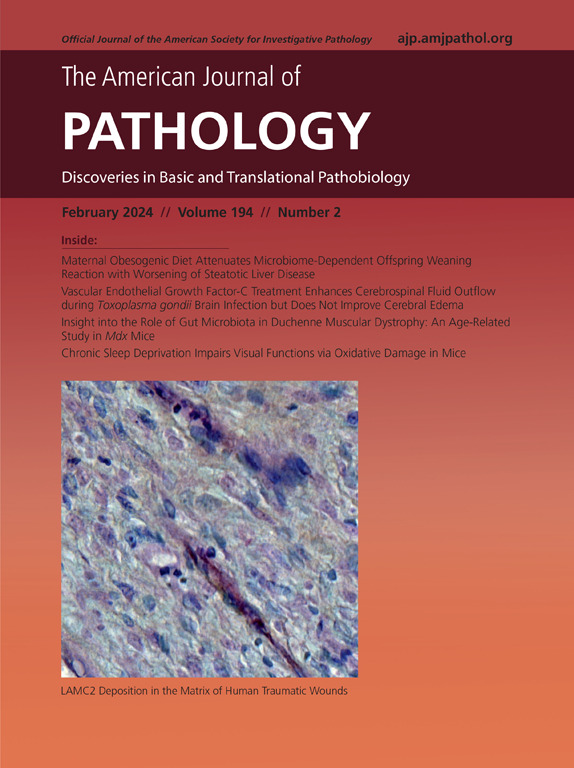Tissue Inhibitor of Metalloproteinase 2 Promotes Wound Healing by Suppressing Matrix Metalloproteinases and Inflammatory Cytokines in Corneal Epithelial Cells
IF 3.6
2区 医学
Q1 PATHOLOGY
引用次数: 0
Abstract
Tissue inhibitors of metalloproteinases (TIMPs) modulate extracellular matrix remodeling for maintaining homeostasis and promoting cell migration and proliferation. Pathologic conditions can alter TIMP homeostasis and aggravate disease progression. The roles of TIMPs have been studied in tissue-related disorders; however, their contributions to tissue repair during corneal injury are undefined. Here, the TIMP expression in human corneal epithelial cells under homeostatic and inflammatory milieus was profiled to examine their contribution to the healing of injured corneal epithelia. Transcriptionally, TIMP2 was highly expressed in human corneal epithelial cells when stimulated with 100 ng/mL IL1B or scratch wounded. Unlike TIMP1, recombinant TIMP2 (rTIMP2) significantly promoted epithelial cell wound closure compared with untreated and TIMP2-neutralizing conditions. At 12 hours, the Ki-67+ cells significantly increased threefold in number compared with untreated cells, suggesting that rTIMP2 is associated with cell proliferation. Furthermore, rTIMP2 treatment significantly suppressed inflammatory cytokine expression (IL1B, IL6, IL8, and TNFA) and injury-induced matrix metalloproteinases (MMP1, MMP2, MMP3, MMP9, MMP10, and MMP13). Topical treatment of injured mouse cornea with 0.1 mg/mL rTIMP2 significantly promoted corneal re-epithelialization and improved tissue integrity. The treatment suppressed the expression of inflammatory cytokines and MMPs, as well as the infiltration of neutrophils at the injury site. These findings indicate that TIMP2 promotes faster wound healing by suppressing injury-induced inflammation and MMP expression, suggesting a potential therapeutic target for corneal wound management.

TIMP-2通过抑制角膜上皮细胞基质金属蛋白酶和炎症因子促进创面愈合。
组织金属蛋白酶抑制剂(TIMPs)调节细胞外基质(ECM)重塑,维持体内平衡,促进细胞迁移和增殖。病理条件可改变TIMP稳态,加重疾病进展。timp在组织相关疾病中的作用已被研究;然而,它们在角膜损伤过程中对组织修复的作用尚不清楚。本研究分析了稳态和炎症环境下人角膜上皮(HCLE)细胞中TIMP的表达,以研究其对损伤角膜上皮愈合的贡献。在转录方面,TIMP-2在100ng /mL IL-1β或划伤刺激下在HCLE中高表达。与TIMP-1不同,与未处理和TIMP-2中和条件相比,重组TIMP-2 (rTIMP-2)显著促进上皮细胞伤口愈合。在12小时时,Ki-67+细胞比未处理的细胞显著增加3倍,表明rTIMP-2与细胞增殖有关。此外,rTIMP-2治疗显著抑制炎症细胞因子(IL-1β、IL-6、IL-8和TNFα)和损伤诱导的基质金属蛋白酶(MMP-1、-2、-3、-9、-10和-13)的表达。用0.1 mg/mL rTIMP-2局部处理损伤小鼠角膜,可显著促进角膜再上皮化,改善组织完整性。治疗抑制炎症细胞因子和MMPs的表达,以及中性粒细胞在损伤部位的浸润。这些研究结果表明,TIMP-2通过抑制损伤诱导的炎症和MMP表达来促进伤口更快愈合,这表明TIMP-2是角膜伤口管理的潜在治疗靶点。
本文章由计算机程序翻译,如有差异,请以英文原文为准。
求助全文
约1分钟内获得全文
求助全文
来源期刊
CiteScore
11.40
自引率
0.00%
发文量
178
审稿时长
30 days
期刊介绍:
The American Journal of Pathology, official journal of the American Society for Investigative Pathology, published by Elsevier, Inc., seeks high-quality original research reports, reviews, and commentaries related to the molecular and cellular basis of disease. The editors will consider basic, translational, and clinical investigations that directly address mechanisms of pathogenesis or provide a foundation for future mechanistic inquiries. Examples of such foundational investigations include data mining, identification of biomarkers, molecular pathology, and discovery research. Foundational studies that incorporate deep learning and artificial intelligence are also welcome. High priority is given to studies of human disease and relevant experimental models using molecular, cellular, and organismal approaches.

 求助内容:
求助内容: 应助结果提醒方式:
应助结果提醒方式:


